J. Kim Wright and Luemara Wagner (with special thanks to Don Beck)

J. Kim Wright

Luemara Wagner
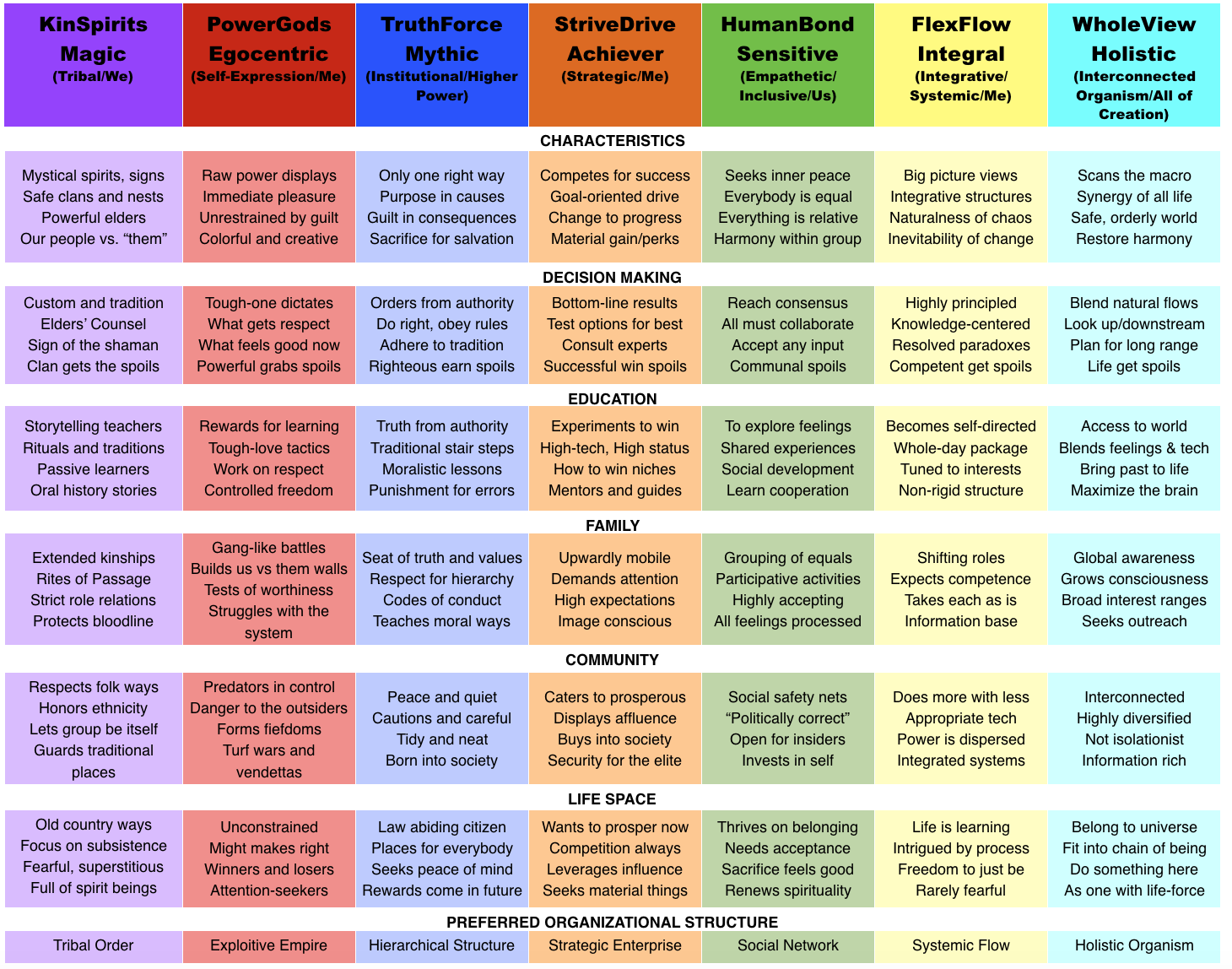
Kim: I was a speaker at the Spiral Dynamics Summit on the Future in Dallas in April and was asked to write an article on the subject covered in my presentation: Legal Wizardry: What will the legal system look like from the values of the Second Tier. Speaking to a predominantly non-legal audience, the presentation hit some high spots and introduced some new ways of looking at law. For the article, I wanted to take a deeper dive, a broader look at the evolution of the legal system and some examples of what is emerging now.
In May, I was one of the hosts of an event for “Integrally-Informed Lawyers” in Denver where I first met Luemara Wagner, face-to-face. We’d talked on the phone before but this was our first real opportunity to engage. I didn’t know her background but I immediately saw that she was very well-grounded in spiral dynamics and law, plus she was aware of many of the developments which have been my subject of study for the last two decades.
When she agreed to work with me on the article, I suspect neither of us knew what we were getting into. We began a series of conversations (sometimes as long as 5 hours!) in which we explored various spiral dynamics topics in the context of law. I can only hope she has enjoyed and been enriched by the conversations as much as I have.
After pages of notes, she offered to create charts to capture our conversations and to begin to organize them into topics and sub-topics. I couldn’t have chosen a better collaborator. The charts gave us a canvas for even more clarity and inquiry.
Lue: I have been actively using the SDi and Integral maps in my practice as an attorney-mediator for many years. Over the course of several SDi-informed presentations, people would approach me and ask if I was working with Kim. Her name kept popping up in my many circles. We finally had a chance to meet face-to-face and start a collaboration. This introductory, high-level article is our attempt to capture some general, preliminary concepts and amplify the conversation.
We welcome dialogue and feedback if the many generalizations and assumptions we’ve made can be refined, corrected and improved.
After many conversations with attorneys and mediators outside of the US, we are aware of myriad cultural differences that alter and influence the local legal process and style, since the legal system is a product of history, culture, traditions, beliefs, and relationships. We intend to address these differences in a subsequent article, particularly the emergence and evolution of common law and civil law systems as a reflection of differing collective realities, living conditions, choices and priorities.
Our primary intention with this first general article is to briefly explore the evolution of legal systems as a reflection and expression of value systems through an SDi lens. We hope to bring forward an appreciation for the increasing abundance of legal options and techniques as the collective balances rights and duties with diverse notions of fairness, justice, due process, rights, agency, self-expression, limits and boundaries. We welcome participation if this topic resonates. Our contact information is at the end of the article.
Initially, we considered maintaining a dialogue format throughout but eventually chose to condense ideas into charts and short paragraphs for readability and to comply with page limits. The charts help to condense a lot of information into a smaller space. Trust us, each one can go deeper and be a separate subject of story, but we’re limited on space and deadlines.
This is our first article on this topic and we expect it to evolve over time as we apply what we’ve created and refine from experience and insight.
Some spiral wizards may question some of our characterizations. We comprehend that we are making generalizations and assuming that behavior is an expression of values. While we understand that, we still believe there is value in using our examples and assumptions.
We wrote not only from our training but our experience of being in the field, interacting with people with different values and how they respond and react to the legal system. If your experiences are different, it could be a rich conversation. The idea of a book has emerged from our collaboration.
Why Would a Non-Lawyer Want to Read About Law?
Effective rule of law reduces corruption, combats poverty and disease, and protects people from injustices large and small. It is the foundation for communities of peace, opportunity, and equity – underpinning development, accountable government, and respect for fundamental rights. The rule of law is not just the rule of lawyers and judges: all members of society are stakeholders.–From the World Justice Project[1]
Lawyers have spent centuries making the law mysterious and unreachable. Making the simple complex seems to be a job requirement, firmly rooted in Blue. Thus, non-lawyers often shy away from Law. (Yes, we even show its importance by capitalizing the word.) It is the unknowable and these days, it costs a lot of money if you inadvertently bump into the legal system.
Actually, as we see it, Law is pervasive. Kim often refers to it as being one of the strands of the societal DNA, wrapping through everything. It goes far beyond the concepts of legislation recorded in books or holdings of court cases. It reflects and shapes values and behaviors. It is the expression of how we relate to each other in society and how our values come into play.
Law is the codification of the societal values. It governs our behavior. It solves (or tries to solve) problems. It tells us what is okay to do and what is forbidden. It defines who is married and who is not. What side of the street do we drive on? What are our building codes? If I am in a car accident, do I pay or get paid? What are our rights and what are our required obligations? What is mandatory and what is optional? Where does my freedom stop and your rights begin?
Value System Models
We know that many readers have entered the Integral Leadership world on different paths. Our frame of reference is Don Beck’s version of Spiral Dynamics, as an extension of the work of Clare Graves, and we are informed by other related models.
The chart below provides a high-level translation table between value system maps, keeping in mind that maps and models allow us to abstract ideas, label observed patterns, describe, communicate, and sometimes even predict and prescribe, but ultimately no map is the territory itself.
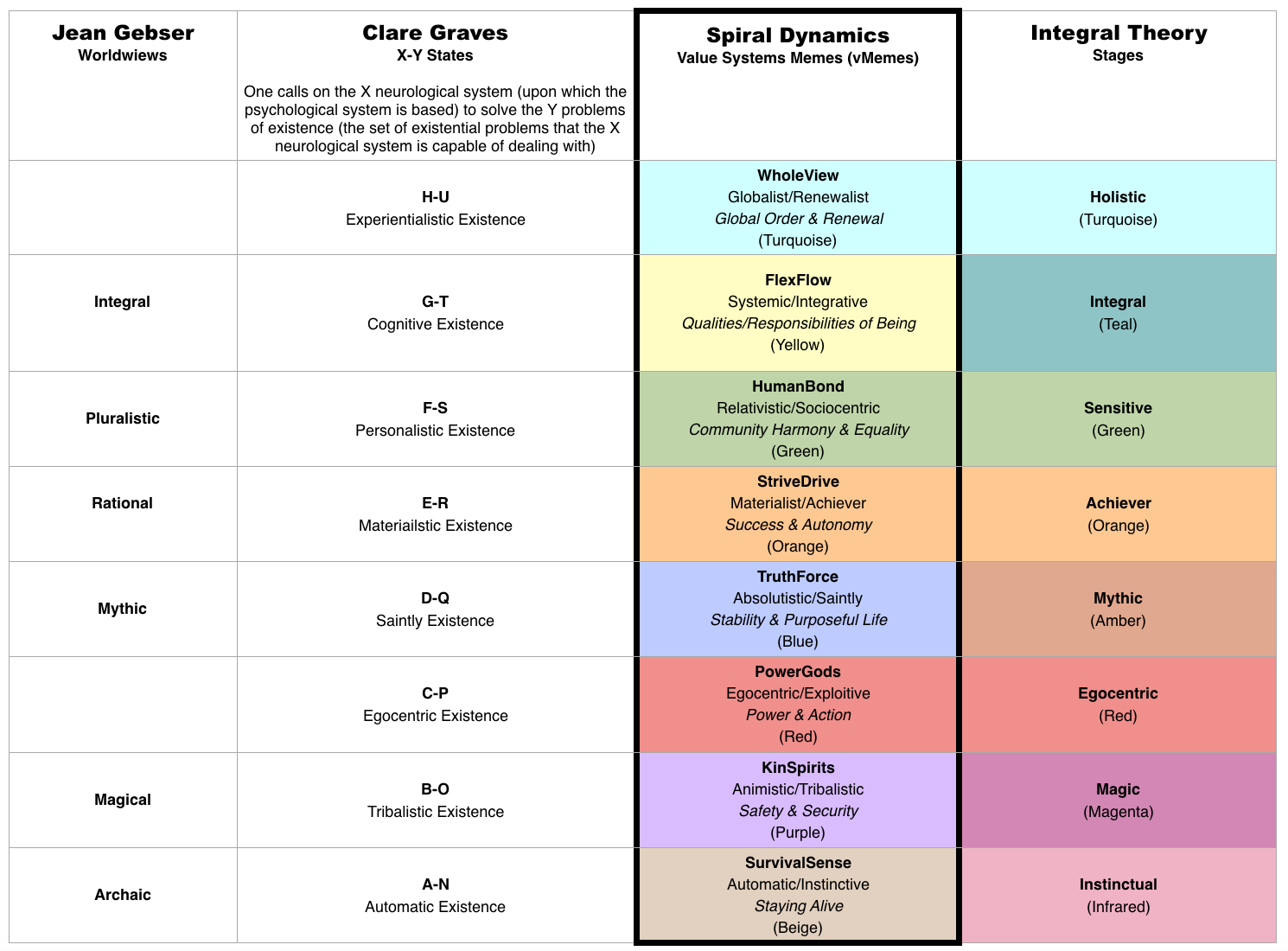
The levels represent degrees of activation in the central nervous system. The brain has modules in it and when different modules line up you see different modes of corresponding belief and behavior with it…. People cannot believe or behave beyond where they are and they have the right to be where they are. –Don Beck
Beige and Beyond
You’ll probably notice that we don’t write a lot about Beige and that it is missing from most of the charts. We actually spent a lot of time talking about Beige. With the opioid crisis, homelessness, violence in schools and communities, decreases in social services, and other shifting environmental conditions, Beige is getting more and more relevant. It isn’t a matter of some primitive pre-tribal historical situation.
We don’t stop having survival needs just because we are at another level. Indeed, it is possible to fall back down the spiral. Someone with a center of gravity in Purple who loses connection with the tribe may find himself without support, living on the streets, and existing in beige for a time. Someone who has enjoyed stable but not lucrative employment may lose her job and end up without a home, struggling for survival.
Drug addictions can hasten the downward spiral. For example, there was recently a New York Times article about a high-power lawyer who became addicted and died. The details of his life pointed to a fall from what was an apparently high-achieving, successful legal career to dependency on drugs and eventually death.
We didn’t ignore Beige. Beige has its own complex issues and we decided that a deep discussion of them would be outside of our scope for this article.
Dismissing the Beige legal system as some sort of “Hunger Games” would be too simplistic. We also noticed that the legal system is currently designed to treat Beige as though it is capable of Blue. We wanted to tease that out a bit more before sharing it.
Key Interests, Core Fears, and the Transitional Factors from One Level to the Next
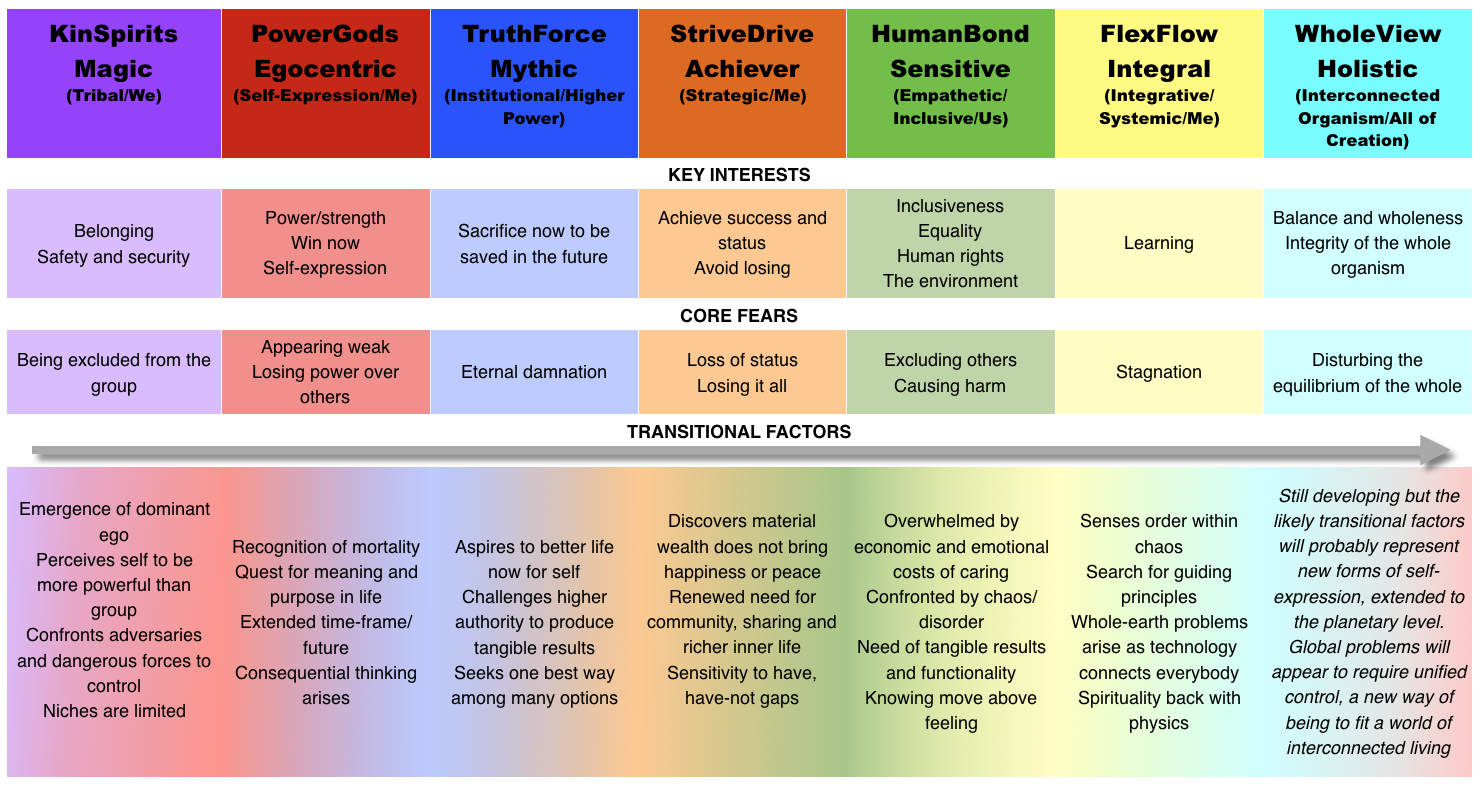
Laws and Legal Systems as an Expression of Individual and Collective Values (Wilber’s Four Quadrants)
There are many paths to Integral Leadership. For those with an orientation toward the integral quadrants, here is a diagram. While the article touches on each of the four, our focus is on the Upper Left and Lower Right.
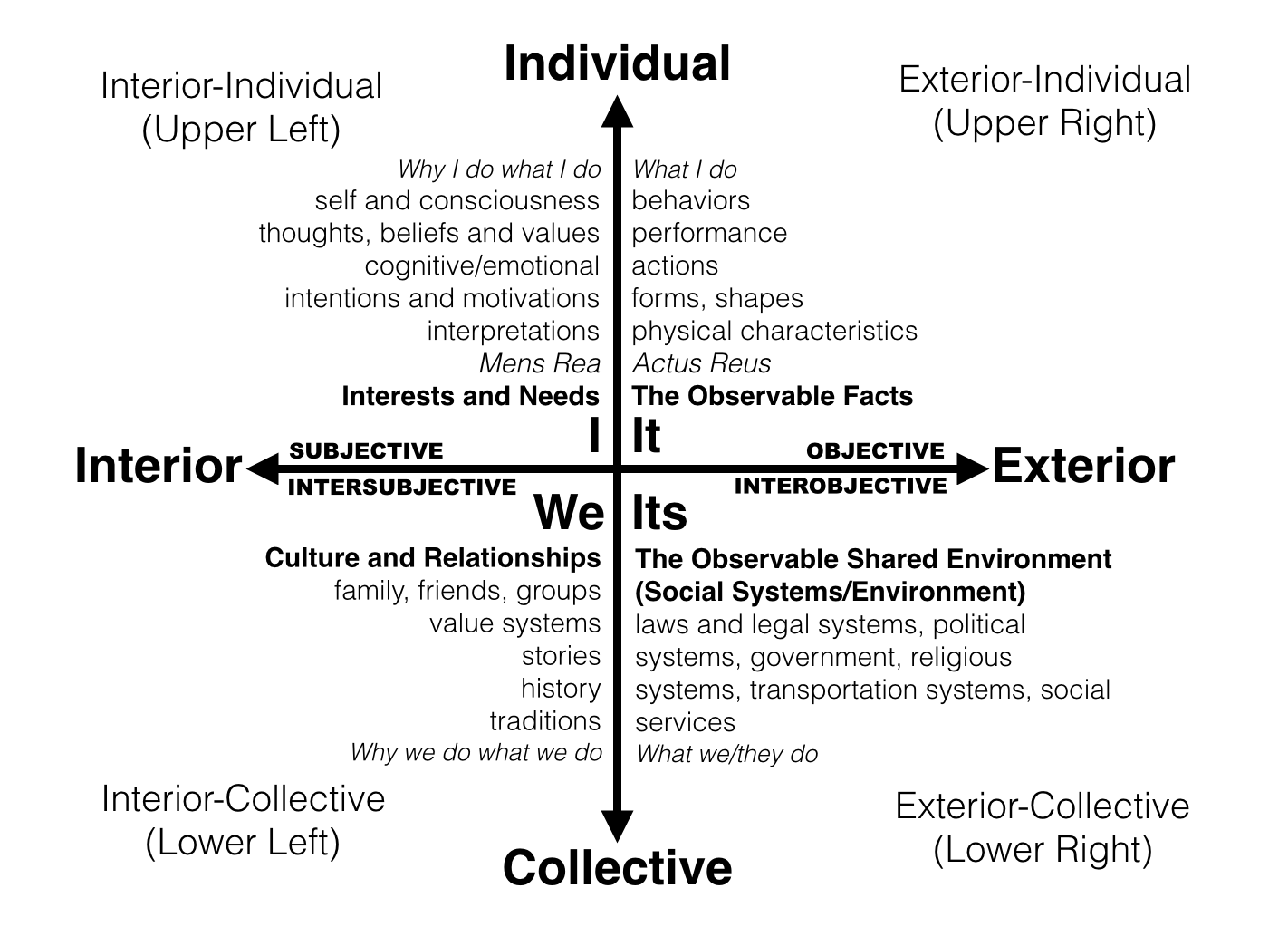
Sources of Laws & Perception of Justice
Where do laws come from? What is fair and just? Who deserves protection? What rights are recognized?
The legal system could be seen as a mechanism for balancing/enforcing rights and duties in an attempt to mediate relationships in a collective composed of individuals at different levels in a value system. As such, it often represents the center of gravity of a society, a forum for the interaction between individual core drives for agency and self-expression and opposing drives for communion, boundaries and collective cohesiveness by imposing limits and consequences on certain behaviors. Beige seeks to avoid its reach. Red enjoys the fight. It regulates and reins in Red and Orange. It satisfies Blue’s need for order and predictability. It helps Orange’s commerce create companies and agreements. Green tries to use it as a tool for anti-discrimination and inclusion. Of course, that is not all, but it illustrates the many faces and uses of the legal system. How do we create a system that feels just from across all these levels?
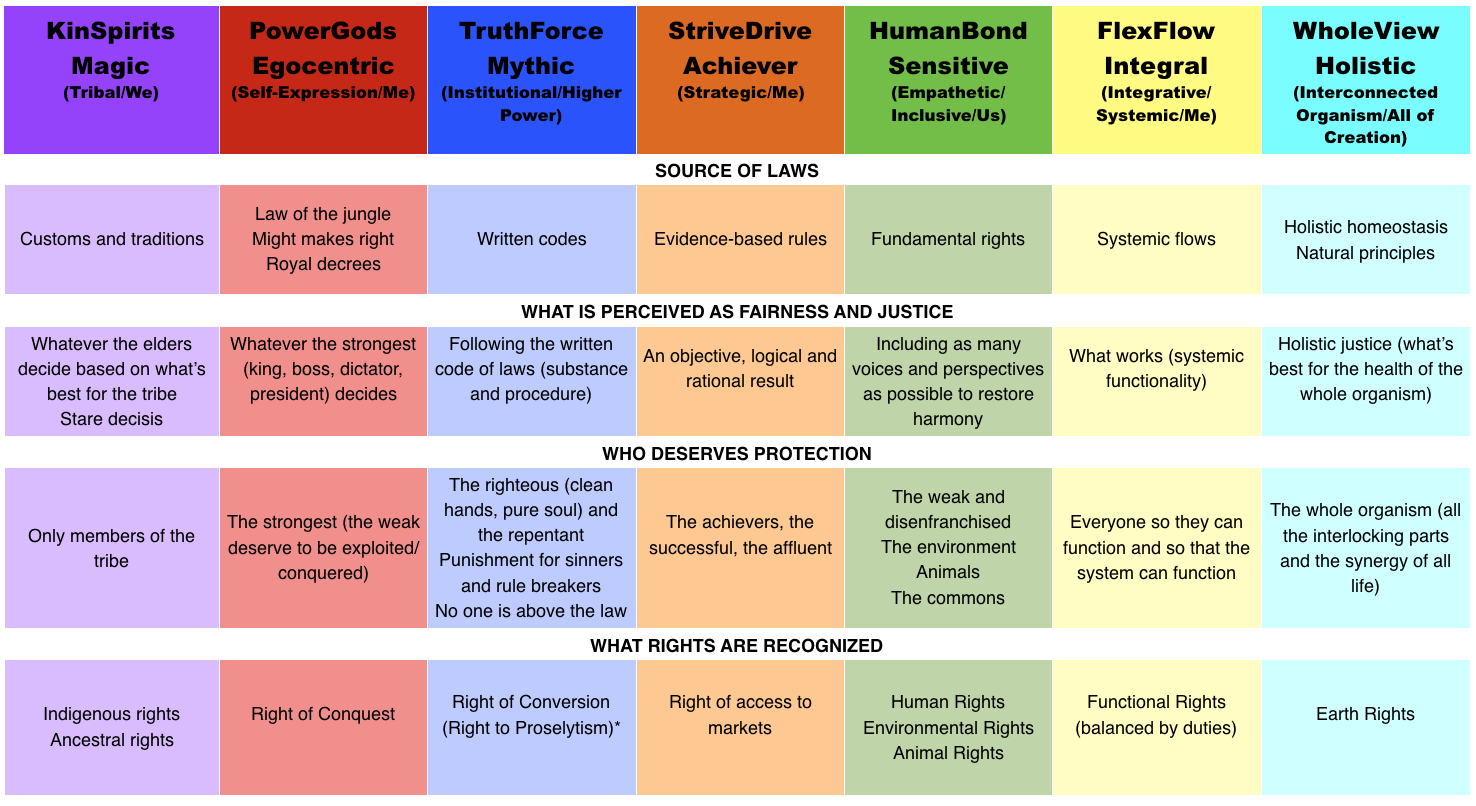
The Evolution of Legal Systems and Dispute Resolution
Magna Carta, Due Process, The Rule of Law, and Procedural Justice
We’re not going to geek out on legal history. We’re going to address it more at the casual conversational level with help from Wikipedia, not from deep research and an evidence approach. Our footnotes and links provide a link to more than our superficial information.
The written, codified legal system as we know it evolved in Blue. Before that, disputes were settled by elders or tribal circles (Purple) or by duels, jousting, wars, or combat (Red). In the US, the cowboys gathered a posse and went after the bad guys, taking care of the problem in gunfights or by a hanging from the nearest tree. Even after court systems were established, vigilante justice and lynchings were used until fairly recently in US history.
As Blue institutions began to come into existence, justice became institutionalized. The Inquisitor model (where the judge is also the questioner) that emerged in civil law countries has its roots in canon law while English common law was built on an adversarial (verbal combat) model.
Over 800 years ago, the Magna Carta codified due process for the common law system: the right to fair treatment in the legal system. “No man of what state or condition he be, shall be put out of his lands or tenements nor taken, nor disinherited, nor put to death, without he be brought to answer by due process of law.”[2] Even older than that, the concept of “no man is above the law” evolved in many different cultures.[3]
The idea of procedural justice or procedural fairness remain current areas of investigation among legal and social science academics, as evidenced by this abstract of a 75-page paper by one of the leading Procedural Justice academic writers:
Legal authorities gain when they receive deference and cooperation from the public. Considerable evidence suggests that the key factor shaping public behavior is the fairness of the processes legal authorities use when dealing with members of the public. This reaction occurs both during personal experiences with legal authorities and when community residents are making general evaluations of the law and of legal authorities. The strength and breadth of this influence suggests the value of an approach to regulation based upon sensitivity to public concerns about fairness in the exercise of legal authority. Such an approach leads to a number of suggestions about valuable police practices, as well as helping explain why improvements in the objective performance of the police and courts have not led to higher levels of public trust and confidence in those institutions.[4]
Courts & Shifting Tribunals
Modern courts look a lot like the old courtrooms of the past. (In fact, many old courthouse buildings are still in use.) They have witness chairs, jury boxes, a raised chair for the judge, a bar between the counsel tables and the public viewers. However, the rules of court are changing constantly.
Blue wanted eyewitness testimony and eschewed circumstantial evidence. Confession was considered good for the soul and many means were used to encourage full admission of crimes committed. Orange now accepts scientific evidence (such as DNA) and expert testimony (although they haven’t always come to terms with hundreds of years of precedent and new findings in neuroscience that contradict them). Juries of peers may have been a nod to the Purple tribe but scientific studying of juries has become big business. The possibility of settling a case meant that Orange could avoid losing. Punitive damages and monetary damages developed in Orange while Green began to look at community service, apology, forgiveness, rehabilitation and reintegration.
Emergence of Arbitration
Arbitration[5] is basically a private court. Unlike the institutional court system, in arbitration the parties choose the arbiter, often someone with a relevant expertise in the subject matter. It is usually much faster than winding through the court system and has the added advantage that it is confidential, not a matter of public record.
Arbitration decisions offer finality because they are difficult to appeal. The clauses generally waive the right to seek a judicial hearing or appeal.
Arbitration clauses are often built into commercial contracts, helping Orange set up the conditions to avoid losses, especially public ones. In recent years, the concept has been questioned as unfair and stacked in favor of the companies, especially in contracts between large corporate entities and consumers. The arbitration clauses are often buried in boilerplate and consumers don’t understand them. Since they often use the same arbiter in many cases and consumers are one-time customers, it is believed that the arbiter is not a neutral at all, but an agent of the company. The decisions are not public so no one knows if the company has a history of bad behavior. Green is offended by the power imbalance and lack of transparency.
Evolution of Non-adversarial Models & Tools
As value systems evolved beyond Blue, methods of Alternative Dispute Resolution (ADR) became increasingly popular. In the US nowadays, most civil disputes settle without even a hearing and it is rare that court-based adjudication is necessary, with only a small percentage of lawsuits going all the way to trial.[6] The more common ADR methods are arbitration and mediation.
Some legal theorists with a Blue center of gravity consider that it is only within courts that justice can be found and find the extension of the concept of justice beyond court-based adjudication to be problematic.[7] However, as a reflection of a diversity of values, the framing of the concept of justice extends beyond traditional Blue notions that focus on the rule of law, finding the truth and determining legal rights. As Orange and Green values become more common, the idea that justice is not primarily to be found in official justice-dispensing institutions also becomes more pervasive. Orange expresses an interest in efficiency, with methods such as arbitration and settlement-oriented counsel. Green brings with it an interest in not only resolving disputes but also addressing the underlying conflict and enhancing the quality of the relations and transactions in which people are engaged, with methods such as facilitative mediation, for example. It is likely that courts will play an increasingly less relevant role in directly providing everyday justice for most citizens in communities that evolve beyond Blue toward an Orange/Green center of gravity.
Traditional Blue court systems not only adjudicate disputes but also compose a common body of legal knowledge by issuing reasoned opinions and following precedent. From a Purple perspective, this common body of legal precedent constitutes a shared, public record of legal experiences and a repository of evolving, collective legal principles as each reasoned judicial opinion is added to the public record. While ADR presents an alternative method for resolving disputes, it does not provide a mechanism for contributing to this shared collective record of legal experiences in the same way that reasoned court opinions do. ADR cases do not share knowledge back with the tribe. Mediation is confidential. Arbitrators typically do not write detailed reasoned opinions and are not bound by precedent. Although much is gained through ADR from an Orange perspective (confidentiality, control, expediency, efficiency, cost savings), on a collective Purple/Blue level there is the sacrifice of a public, shared record of experiences that traditionally would constitute a sort of judicial tribal wisdom.
Models in Mediation
Most people are familiar with the court system, a Blue invention. A few are acquainted with some form of mediation. Mediation is an intervention by a neutral third party in an attempt to resolve a dispute. It sounds simple enough until you realize that there are many models and ideas about what mediation is.
One could argue that mediation has always been around. In ancient indigenous cultures, the tribe sat around the fire and told their stories to elders who helped them to resolve conflicts. Today, there are many configurations of how the conversations occur and among whom. Evaluative mediators (often retired judges), hear the facts and make recommendations for resolution. Facilitative mediators help flesh out the underlying interests and assist the parties in crafting solutions that resolve the problem. And there are more models, all carrying the name of mediation but often looking very different in their application.
Some forms of mediation are better suited for some values systems. Since mediation is not in the limelight in movies and dozens of television shows, like Law & Order and its dozens of cousins, most people have never encountered mediation and on the rare occasion they have, they are familiar with only one kind.
We think it is good to have some familiarity with the possibilities, a view of the possible toolbox, and to understand how each responds to the levels.
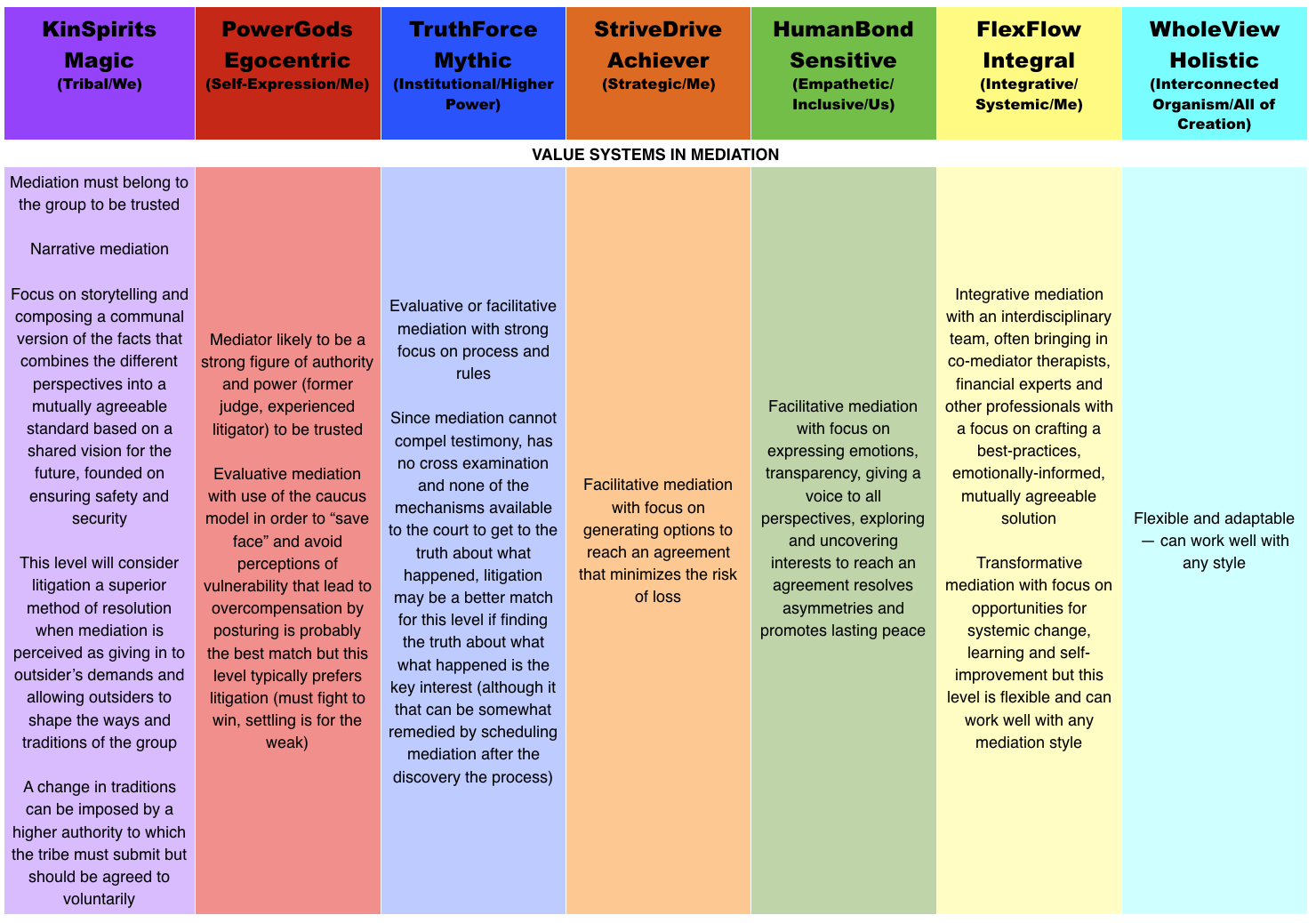
The New Non-Adversarial Models
As with other disciplines, law has evolved as society has evolved. Legal Education was designed around litigation. Prospective litigators learn the skills of verbal and strategic combat (Red). Historic precedent, rules of procedure, and legal substantive courses are required learning, ingrained and tested (Blue). Students are taught that “thinking like a lawyer” requires setting aside all emotions and focusing on logic and reason. Evidence is an important part of the curriculum. Typically, even courses on Legal Counseling are taught based on theory, not practice (Blue/Orange).
While several studies have encouraged law schools to include more “soft skills” and “experiential learning,” educational institutions have been resistant to change. Law students learn not to mention relationships, harmony, peace, or any possibility of alternatives fighting it out in court (Green).
The legal culture reflects this rejection of Green. Subgroups often organize around slash-and-burn litigators (Red), (Blue) transactional and process-oriented attorneys (or solicitors), and rational, strategic Orange competitors.
The legal profession faces challenging life conditions: lawyers experience high rates of addiction, depression, and suicide; low prestige and trust; lack of civility; and a sense of isolation and loneliness far higher than average. The criminal justice system is fraught with overcrowding and police misconduct. Law students graduate with huge debt and about a third of them don’t have a law-related job even within a year of graduating. Statistics for access to justice, i.e. being able to hire a lawyer, show that even though 70% of lawyers do pro bono work, 75% of people who have legal needs cannot afford a lawyer. The challenges provide the conditions for transition.
As lawyers look for new ways to practice law that are more aligned with their value systems, they find or invent new models, tools, and approaches. Orange’s version of innovation is about new billing methods, business models, data and technology that promises more efficiency. Other new models arise in Green, Yellow, and even Turquoise.
These new models reflect not only the consciousness of the individuals who create them, but also respond to the combined efforts of many individuals, bringing the new models into higher levels.
A note of caution: As these new models have emerged, they have often been adopted by legal systems in different values systems. Thus, for example, Collaborative Law, created in flexible Yellow, is also offered in more Blue systems as a process with an often rigid and unyielding structure. Orange systems occasionally embrace it because they like achievement and they don’t want to miss the boat on a good marketing opportunity.
The following are some examples of new models, approaches, and tools which we have seen that seem to be coming from Green or Yellow. We also identified two potentially Turquoise models. We judged them by their values and workability while considering the center of gravity of those practicing in the areas. It isn’t scientific; indeed, we moved a couple of them around, moved them back, and finally settled on where they are.
Developments From Green
Restorative Justice
Restorative Justice is one of those models that shows up in multiple levels, but the center of gravity seems to be Green. The predominant values are inclusion and equality. It is a different approach to those involved and affected by crime than the traditional judicial system provides. The focus is on healing the harm of crime for everyone.
Restorative justice engages all parties involved in the healing process after a crime has been committed. While the institutional legal system focuses on whether the accused has rights, RJ includes healing the victim and grants rights to the victim. Recognizing that crime affects communities. RJ also seeks ways to involve and heal community.
RJ doesn’t seek to punish the perpetrator, but to heal him as well. (Note in many RJ communities, the terms victim and perpetrator, wrong-doer, and especially defendant are frowned upon. “Author of the act” is one preferred alternative.)
Through taking full responsibility for their actions, the “author” begins to take steps to find solutions to help heal the harm they have caused and to be accepted back into the community. Apology and forgiveness are often part of the process.
Restorative justice is not a particular program but is an approach to justice. It contains several different models and processes. You might recognize restorative justice by one of its several names:
- Truth and Reconciliation Commissions (such as that made famous in South Africa)
- Peace-making, sentencing, other circles (a variation of the Purple community circles)
- Restorative School Discipline & Anti-Bullying programs
- Family-group conferencing
- Restorative Community Service
- Victim-Offender Conferencing/Mediation/Reconciliation
There are thousands of restorative justice programs around the world. New Zealand’s legal system is based on this model. In the US, Colorado leads the way to bringing RJ into the mainstream.
Sharing Law[8]
As the world’s economic and ecological meltdowns demand that lawyers redesign their livelihoods, enterprises, communities, organizations, food system, housing, and much more, transactional lawyers are needed to aid in an epic reinvention of the economic system.
This reinvention is referred to by many names—the “sharing economy,” the “grassroots economy,” the “new economy.” The new economy facilitates community ownership, localized production, sharing, cooperation, small scale enterprise, and the regeneration of economic and natural abundance. Sharing economy lawyers help the numbers of social enterprises, cooperatives, urban farms, cohousing communities, time banks, local currencies, and a vast array of unique organizations arising from the sharing economy.
Sharing lawyers support community resilience and grassroots economic empowerment. The lawyers provide essential legal tools – education, research, advice, and advocacy – so communities can develop their own sustainable sources of food, housing, energy, jobs, and other vital aspects of a thriving community.
There are nine primary areas of work that sharing economy lawyers should become familiar with, and each is addressed in a chapter of Practicing Law in the Sharing Economy [American Bar Association, 2012]:[9]
- Designing and Drafting Agreements
- Choosing, Forming, and Structuring Entities
- Advising on the Legalities and Taxation of Exchange
- Navigating Securities Regulations
- Navigating Employment Regulations
- Navigating Regulations on Production and Commerce
- Managing Relationships with and Use of Land
- Managing Intellectual Property
- Managing Risk
Sharing Law has Yellow potential. It has also sparked projects for raising mission-aligned capital, experimenting with business models, and even a program for training prospective lawyers through apprenticeships, by-passing law school. Geographically, it is popular in the US State of California and in Australia.
Green Communication Models
Any of these models could arguably be in other levels but seemed to best match Green in their current expressions.
Plain language
We’ve all read those legal documents full of “heretofores” and “abovementioned party of the first part shall….” and legal jargon that makes the agreement completely inaccessible and unintelligible. We’ll tell you a secret: even we lawyers can’t understand some of those documents.
Plain language is the approach for people who are concerned about the clarity and user accessibility of those documents.
Plain English is clear, straightforward expression, using only as many words as are necessary. It is language that avoids obscurity, inflated vocabulary and convoluted sentence construction. It is not baby talk, nor is it a simplified version of the English language. Writers of plain English let their audience concentrate on the message instead of being distracted by complicated language. They make sure that their audience understands the message easily. –Professor Robert Eagleson, Australia
There are thousands of trainers and practitioners of Plain Language around the world. While most of it is probably centered in Blue, it is a tool for all levels.
Nonviolent Communication
Nonviolent Communication (NVC) is a tool that is often used in restorative justice and other Green or Second-Tier approaches. Nonviolent Communication is a model based on principles of nonviolence. It provides a structure for conversations with an emphasis on deep listening — internally as well as with others. Its goal is to help people discover the depth of their own compassion and to communicate from that perspective.
The NVC model helps the speaker learn to clarify what they are observing, what they are feeling, the values they want to live from, and how to make a request of others in an effort to fulfill those needs. Psychologist Marshall Rosenberg developed NVC (also known by names such as Compassionate Communication) in 1969 and thousands have been trained around the world. Other models have evolved from NVC, including Mindful Communication which integrates the principles of Mindfulness-Based Stress Reduction (MBSR) with NVC.
For more information, see http://www.cnvc.org/.
PNDC
From the website of Sharon Ellison, author, trainer, and creator of the model:
PNDC stands for Powerful Non-Defensive Communication™, a new paradigm that is a dramatic departure from our traditional methods of communication, which are based on the “rules of war.” I’ve spent most of my life developing this process because it never made sense to me to use the use the same rules for two such completely different activities — war and conversation.
Each of these two systems of communication is as precise as a software program. Each provides a specific framework for how we talk to each other. Each achieves different outcomes. The War Model is a system for using defensiveness for self-protection and power struggle to achieve our goals. It is literally designed to create and accelerate conflict, which ultimately undermines our ability to achieve our goals and creates much needless pain in our lives.
The PNDC Model is a system for protecting ourselves without getting defensive and achieving our goals without resorting to power struggle. The outcome is that we can be direct and honest, open and transparent, gaining integrity while keeping spontaneity. We are more likely to feel compassion for others, while having the capacity to create clear boundaries. We can build the kind of character that enhances our own creativity and success, while prompting others to have greater respect and caring for us. More . .
The Collaborative Law community has particularly embraced PNDC.
From Yellow:
Collaborative Law (Collaborative Practice)
Collaborative Law was created by Stu Webb, a Minnesota family lawyer. Stu was a divorce lawyer who didn’t want to go to court any more. He saw that litigation was harming families, especially children, and he decided to create another approach. Stu is a very flex-flow kind of guy and he created a model that had few rules and lots of heart. Not long afterward, some Blue folks got hold of his model and created a lot of rules, but the heart of his process remains Yellow.
Collaborative Law is a method of practicing law where the parties and the lawyers representing them sign a contract in which they agree to work towards settlement. If the parties are unable to settle and adversarial proceedings are to be filed, the lawyers are required to withdraw. New lawyers must be obtained for trial. Multi-disciplinary teams are often used it this model, to gain the expertise and perspective of many. Mostly used in divorce, a full collaborative team might include two lawyers, a child specialist, mental health therapists to serve as coaches to each party, and a neutral financial advisor.
In this method, the attorneys must focus on settlement and are free to use their creative problem-solving skills. Communication is respectful, and the process is future-focused.
In some communities, collaborative approaches are being adapted for business disputes, employment, probate and estate matters, and contract formation. The Basque region of Spain is applying the model (often modified) in all of those areas.
It works best if several lawyers in the community are trained in collaborative law so there are options for the clients and lawyers to work together. There may be as many as 50,000 lawyers trained in Collaborative Practice.
Therapeutic Jurisprudence
Therapeutic Jurisprudence, “TJ”, is a holistic, interdisciplinary perspective that focuses on the law’s impact on the emotional and psychological health of the participants, clients, lawyers, and judges. It spans the first tier with academics involved in research and writing about the legal system and addiction, mental health, disabilities, and more. TJ practitioners and researchers challenge laws that negatively impact those who lack power or competency, create new models that work better for all, not a chosen few. Their research was at the heart of the creation of the Problem-Solving court movement.
The goal in TJ is to bring sensitivity into law practice and it focuses on listening to participants with an awareness of the psychological and emotional issues including stress, confidence, trust.
We finally put TJ in Yellow because of its application and infiltration across the first tier. As an academic movement, it brings together innovative thinkers and writers from around the world.
Problem-Solving Courts
TJ was a core component of the development of the Problem-Solving Court model. In our complex society, courts are increasingly being asked to address social problems that are not compatible with the traditional system of adversarial justice and punishment. Recurring problems – such as drugs, homelessness, domestic violence, child neglect and abuse, mental illness, driving while intoxicated – come before courts every day. Veterans returning from war zones return traumatized and often can’t fit into society. Problem-solving courts attempt to address the recurring problems which lead to the criminal offense.
In 1989, the first drug court was started in Miami, Florida and since then, thousands of problem-solving courts have sprung up across the United States and around the world. Problem-solving courts focus on treatment of the underlying issue rather than incarceration. For example, if someone writes bad checks to pay for drugs and is arrested, the drug court approach would be to create a structure of support to get the defendant off drugs. The defendant would likely be regularly drug-tested, required to attend a program such as Narcotics Anonymous, obtain housing and employment, etc. The support structure might include drug treatment, social services, and a whole team of resources. The defendant must comply with the case plan set out for him or her, often over a period of up to three years, or the case reverts to the punishment system.
Judges in problem-solving courts generally take a therapeutic jurisprudence approach whereby they see each defendant as a human being and recognize the role of the court as having opportunity for impacting lasting change. They meet them where they are, often providing the support and structure to move someone from the brink of survival to becoming a productive and respected citizen of a community. In spiral terms, the courts provide the Blue structure that helps someone move from Beige to higher levels. Many such judges become parental figures, meting out advice, enforcing consequences, and cheering for success.
The problem-solving approach is particularly poignant in the case of mentally ill defendants who may just need the proper medical care to live normal and productive lives. Studies have shown that a large percentage of incarcerated individuals have issues with mental illness.
There are thousands of Problem-Solving Courts in some twenty countries of the world.
New Models of Contracts
When you think of a contract, you probably think of pages of text, most of which may not even apply to you. If you’re like most people, you don’t read the contract and you don’t ever get it out of the file drawer unless you need to use it as a weapon when things go wrong.
A contract is actually a private legal system. You can create the rules for your relationship, how you will engage, expectations, dispute resolution system, etc. You wouldn’t know that by looking at most contracts. Most look like you are preparing for war, not creating a future.
Two different Yellow models have emerged.
Values-Based Contracts
A Values-Based Contract begins with a conversation about the values of the parties. The parties state their own values, then look for common values, common goals, and a common way of communicating. That initial conversation helps to ascertain whether the parties can work together and it creates a context for the rest of the agreement. That is, the language of the contract then aligns with the values. The content and promises are aligned. The structure for how the parties relate to each other is consistent with those values. The way change is addressed and conflict is engaged are specifically connected to the stated values and the resolution system is consistent with it. Instead of having the court as the arbiter of conflicts, the model helps parties from different levels to co-create a structure that works for their unique values and circumstances.
See, for example, Kim’s article in Conscious Company Magazine: https://consciouscompanymedia.com/sustainable-business/stop-being-scared-of-your-legal-documents/
Sample values statement and process for addressing change and engaging disagreement for an organization of lawyers: http://forrestwebb.net/our-charter/
Comic Contracts
Living in a developing country, and one of the world’s most unequal societies, South African commercial attorney Rob de Rooy decided to do something about the vulnerability of people when they sign contracts, and especially people that are poor and illiterate. From this the idea of using comics for contracts was born. Comic contracts are legally binding illustrated contracts. Originally intended for illiterate people, they are now being used for many other purposes. In Australia, Aurecon, an international engineering firm, has chosen to use the comic book contract for their employment contracts because they are easier to understand and streamline the process, making contracts more succinct and meaningful.
In 2016, Rob won the prestigious innovation award for the IAACM (International Association of Contract and Commercial Management.)
See: https://www.aurecongroup.com/about/latest-news/2018/may/visual-employment-contract and http://www.enliveningedge.org/columns/picture-worth-1000-words/
https://creative-contracts.com/
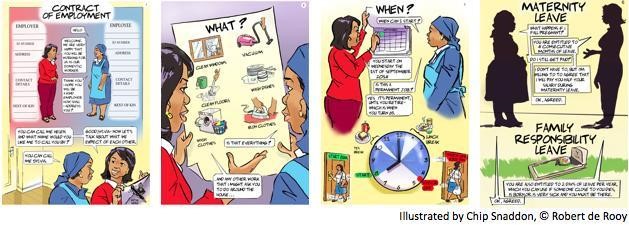
[10]
Structured Negotiation
Structured Negotiation is an alternative dispute resolution process created by California-lawyer Lainey Feingold. It is a method for negotiating comprehensive agreements without lawsuits. Lainey seeks to solve civil rights claims of blind people. Instead of rushing to court to sue for violations of the Americans with Disabilities Act, she contacts the company and offers to help them resolve the problem, not only for her client but for everyone impacted. The negotiation process fixes the bug and settles the damages portion that would have been litigated in a lawsuit.
Lainey was recognized by the American Bar Association Dispute Resolution Section with the annual Lawyer as Problem-Solver award in 2017 and her 2016 book on the topic has been an American Bar Association best-seller. She has worked with some of the largest organizations in the United States. Bank of America, Major League Baseball and the City and County of San Francisco have all participated in Structured Negotiation.
While the method has application to a wide variety of civil claims where parties seek collaboration and solution over conflict and expense, it has not yet been widely used in other cases. Read more about Structured Negotiation.
We placed Structured Negotiation in Yellow due to its success in integrating Blue, Orange, Green values into a workable, flexible structure.
From Turquoise
Holistic Law (aka Holistic Justice)
In the 1990s, the concept of Holistic Law or Holistic Justice began to come into being. It seemed to begin in several places at the same time, reflecting a shift in consciousness from lawyers who didn’t even know each other. Many started putting “Holistic Lawyer” on their business cards. One of those, Vermont lawyer Bill van Zyverden, created an organization: The International Alliance of Holistic Lawyers (IAHL). It attracted and provided a home for dozens of lawyers who were stepping outside of the usual approaches to law practice.
Some of the Holistic Lawyers were innovators. Kim met Stu Webb, the creator of Collaborative Practice, Bruce Winick and David Wexler, creators of Therapeutic Jurisprudence, and many other paradigm-shifters there.
But, beyond being a home for innovators, the Alliance became a place where new ideas about interconnectedness of all beings came together with questions about how to be a lawyer, what should/would the legal system look like, and how to integrate being a human on a living planet. Spirituality was discussed in the same conversation as ecology, with legal design theory in the next paragraph.
The IAHL dissolved after twenty years. Many lawyers are still engaging in those inquiries and calling themselves “holistic lawyers.” The membership is scattered among the other Green and second tier models. They’ve been part of a movement to bring mindfulness practices to law, to integrating law and yoga, to leading Earth Law efforts, and many other expressions.
Earth Law
If there is a Turquoise model, it is Earth Law. Some people confuse that with the discipline of environmental law which may have its roots as far back as a 1610 torts case and property case involving a stinky pig sty[11]. Wiki defines it as follows:
Environmental law – or “environmental and natural resources law” – is a collective term describing the network of treaties, statutes, regulations, and common and customary laws addressing the effects of human activity on the natural environment.
And therein is the problem for most Earth Lawyers. Environmental law is about regulation – very blue. It measures how much toxic waste we can put into the environment, what resources can be removed or polluted. A common complaint from environmental lawyers is that they got into the profession because they wanted to make a difference: pushing paper around doesn’t save the earth. It assumes that the Earth is a thing and that people have property rights that allow them to do whatever is within the regulations.
Earth Law, aka Earth Jurisprudence, Wild Law, and various other names, emerges from the sense of oneness with the Earth. It is less about the regulations which allow a certain amount of toxic waste to be emitted into the water supply, and more about interconnectedness and wholeness.
From South African Cormac Cullinan, Wild Law: A Manifesto for Earth Justice, 2011.
I know that “wild law” sounds like nonsense — a contradiction in terms. Law, after all, is intended to bind, constrain, regularize and civilize. Law’s rules, backed up by force, are designed to clip, prune and train the wilderness of human behavior into the manicured lawns and shrubbery of the civilized garden. “Wild”, on the other hand, is synonymous with unkempt, barbarous, unrefined, uncivilized, unrestrained, wayward, disorderly, irregular, out of control, unconventional, undisciplined, passionate, violent, uncultivated, and riotous. (…) A wild law is a law to regulate human behavior in order to protect the integrity of the earth and all species on it. It requires a change in the human relationship with the natural world from one of exploitation to one of democracy with other beings. If we are members of the earth’s community, then our rights must be balanced against those of plants, animals, rivers and ecosystems. In a world governed by wild law, the destructive, human- centered exploitation of the natural world would be unlawful. Humans would be prohibited from deliberately destroying functioning ecosystems or driving other species to extinction.
Earth Law also has a prominent presence among Green and Yellow groups. Activists have been successful in having an environmental cause of action adopted by the International Criminal Court.[12] There is the Ecocide movement, dedicated to creating a fifth crime against humanity in addition to genocide and others, with a strong following amongst lawyers and left-wing politicians in the UK, USA and other jurisdictions, but has as of yet failed to get any new laws onto the statute books.[13]
Several organizations are working toward adoption of the Universal Declaration of the Rights of Mother Earth. Rights of Nature is obviously not yet mainstream but the movement can claim some success. Rivers in New Zealand, India, and the USA have been declared to be legal persons, with their own rights.[14] For example, the sacred Ganges River in India was recently given standing as a legal person. Bolivia has included Rights of Nature in their Constitution (although it is reported that they’ve not fully embraced the possibility.) Some communities have adopted Rights of Nature ordinances, some of which have particularly been aimed at fracking.
The Global Alliance for the Rights of Nature is “a network of organizations and individuals committed to the universal adoption and implementation of legal systems that recognize, respect and enforce “Rights of Nature” and to making the idea of Rights of Nature an idea whose time has come.”
The primary premise of the Alliance is that in order to insure an environmentally sustainable future, humans must reorient themselves from an exploitative and ultimately self-destructive relationship with nature, to one that honors the deep interrelation of all life and contributes to the health and integrity of the natural environment. An essential step in achieving this is to create a system of jurisprudence that sees and treats nature as a fundamental, rights bearing entity and not as mere property to be exploited at will. Breaking out of the human-centered limitations of our current legal systems by recognizing, respecting and enforcing Rights of Nature is one of the most transformative and highly leveraged actions that humanity can take to create a sustainable future for all. From: http://therightsofnature.org/fundamental-principles/
Former London structured finance lawyer, Mumta Ito, left her City Law job and sought a spiritual path which included traveling with Amma. Mumta, now living at Findhorn, is the CEO of Nature’s Rights and writes and speaks broadly. This is from an article she wrote for The Ecologist:
Modern law in most countries operates within the following outdated paradigms:
- mechanistic (i.e. viewing the world as made up of separate unconnected objects interacting in a predictable way);
- anthropocentric (i.e. viewing the world as existing solely for the use of human beings – this is where ideas about ‘natural resources’ and ‘natural capital’ derive basing nature’s value on its utility to humanity rather than on its intrinsic value); and
- adversarial (competitive/retributive model where one party wins at the expense of another)
None of these paradigms reflect the full scientific reality of how natural systems operate. This gives rise to the illusion of a ‘power-over’ relationship with nature which has led to our current predicament.
Being a part of nature, we cannot harm nature without also harming ourselves. Science has long recognised a fluid and complexly interconnected world.
A Movement in Law?
Many of the lawyers practicing in the areas described are organizing under the banner of the “Integrative Law Movement” (which may actually be a more Yellow movement). Kim’s two books, Lawyers as Peacemakers: Practicing Holistic, Problem-Solving Law and Lawyers as Changemakers: The Global Integrative Law Movement, showcase individuals who practice in these and many more models. There are many more.
As a percentage of the world’s approximately 2.2 million lawyers, it is a small group, but they are growing in influence.
Remedies, Punishment, and Restoration
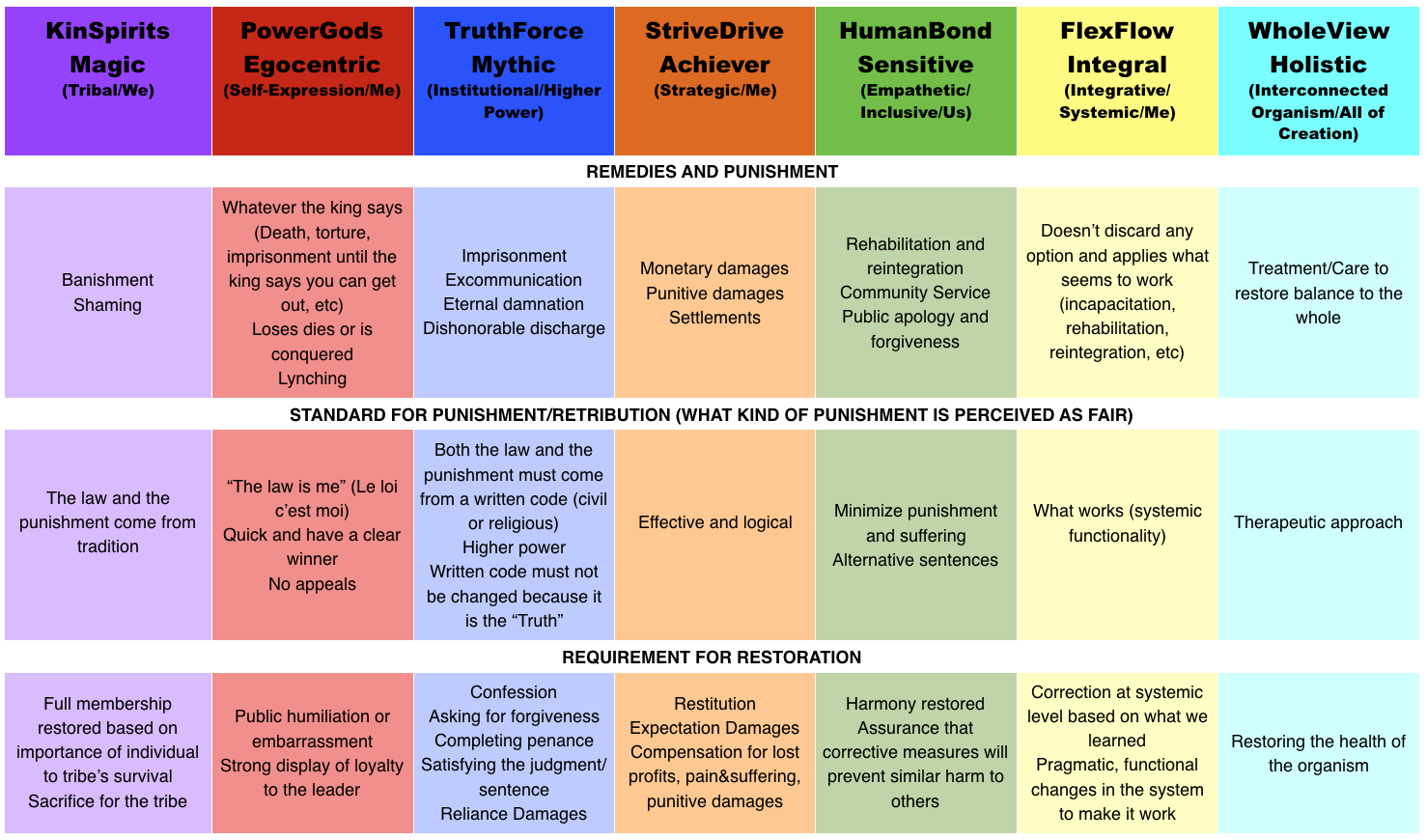
A remedy is how a court enforces a right, imposes a penalty, or imposes its will through another court order. Injunctions that order something to stop, specific performance that orders something to be completed, and monetary damages are examples of civil remedies. Punishment and restitution are examples of remedies in criminal law.
Kim’s daughter, Ayni, lives in New Orleans and works in the French Quarter. There is strong Purple among the tribe of workers in the Quarter and Ayni is a prominent and beloved member of the tribe. Her house is a gathering place and she serves as a safety net for those who lose their jobs or fall onto hard times.
Recently, someone broke into Ayni’s house and took thousands of dollars. Kim asked Ayni if she had called the Police (Blue). She had not. She said that she was sure the money was gone and she’d never get it back. The Police wouldn’t be able to help her with that. Something much worse happened to him, she told me: he’s been banished from the tribe. Everyone has agreed that if he ever shows his face, they will turn their backs on him.
Having violated the sacred tradition of the tribe, what would happen if the aberrant member tried to return? What sort of apology would be required? According to our conversations about Purple, he would have a tall hurdle: to get back in the tribe’s good graces and be fully restored, he’d have to find a way to become valuable to the tribe, at some sacrifice to himself.
Contrast this with what might happen in the Red level where the punishment might be final and unrestorable: off with his head!
Blue, of course, would have called the Police and let the authorities hold it. If this had happened in a religious community, hell and damnation would have been more permanent than merely the guillotine. We would hope that he would beg for forgiveness.
Orange is going to be concerned about getting the money paid back.
Green is concerned about the relationship of the tribe and what it would take to restore harmony. Yellow will be looking at what will be most functional for the system and may pick from a number of possibilities.
We don’t have Turquoise examples in law yet, but we imagine it might show up as a therapeutic approach. Since each of us is part of a whole, we don’t punish our big toe for stubbing itself, but we might want to treat its injury.
Shaping Behavior
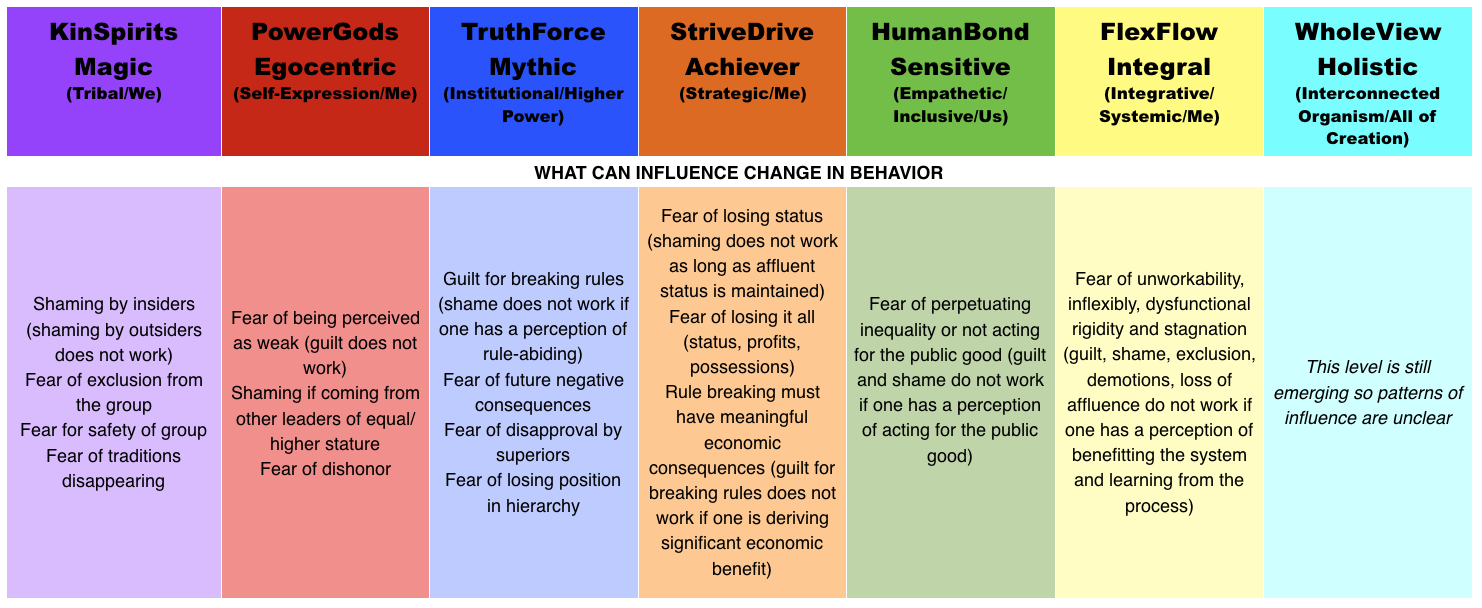
Blue codifies remedies and punishments. At least in theory, if you break this law, x, then you get that consequence, y. (There are enough factors at play that it doesn’t happen that way, but it is part of Blue’s goal.)
But the rest of the levels do not share Blue’s zeal for the codified, the-more-rules-the-better system. If we really want to shape behavior, what works?
Many people have heard of the Hot Coffee case. Many people use this as an example of lawsuits run amuck.
A woman bought a cup of coffee at a McDonald’s, spilled it, and was severely burned. However, that was not the whole story. It turned out that McDonald’s knew that the coffee was hot enough to scald and injure a customer if spilled. The manual called for coffee to be served at 180-190 degrees and an evidence showed that such a temperature would cause third-degree burns in a matter of seconds. Indeed, the woman was hospitalized with severe burns for several days and the quality of her life was drastically diminished because of her injuries. The company had known about the risk for ten years. Evidence showed that 700 other customers had been burned but that the company did not consider that significant, given the billions of cups of coffee they sold.
The jury was concerned about the disregard for the safety of customers. After the trial, “one of the jurors said over the course of the trial he came to realize the case was about ‘callous disregard for the safety of the people. Another juror said ‘the facts were so overwhelmingly against the company.’”[15]
Although it was later reduced by the judge and subsequent appeals, the original judgement for compensatory and punitive damages totaled more than $2.9 million.
The jury intuitively knew that the way to get McDonald’s attention was to hit them in the pocketbook, that by doing so, they might change their behavior.
And McDonald’s reduced the temperature of their coffee.[16]
The Temptation to Lie, Cheat and Conceal
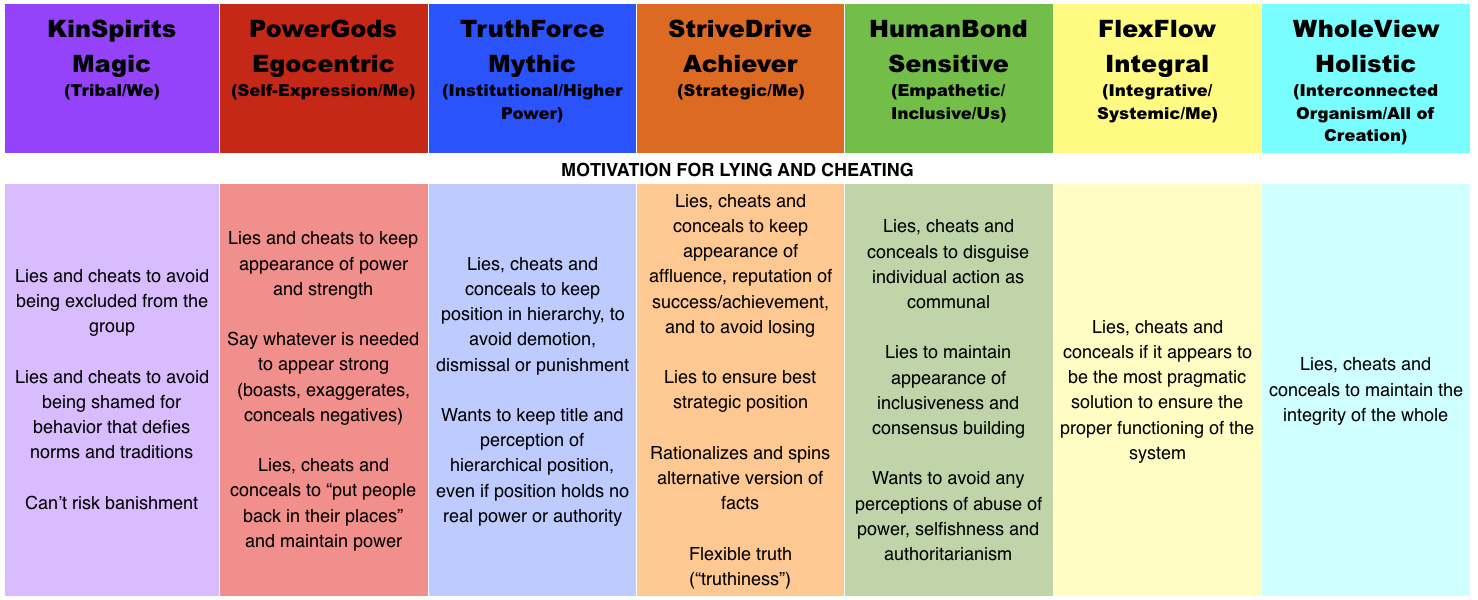
We all know that when witnesses are sworn in, they swear to tell the truth, the whole truth, and nothing but the truth. But what if they lie? What is the motivation for lying? What is big enough, important enough, to lie, cheat, and maybe even steal (or worse)?
In each level, the motivation is different. This chart shows some of our conversations about that topic.
What Is Peace
In their intimate moments, many lawyers admit that they were called to law and eventually to mediation or one of the other models because they were interested in creating world peace. Therefore, we end this article with a chart that shows us what peace is, how it shows up in each level.

Conclusion
The law is a reflection of the values in society. The legal system unifies the different levels and creates an agreed center of gravity.
As we said in our introduction, this is an ongoing conversation. We encourage other lawyers who are spiral wizards to join us in the inquiry and sharing of experiences. Those practicing in the civil system are especially invited to join us so we can offer a comparative process and cross-understanding.

References
[1] https://worldjusticeproject.org/sites/default/files/documents/WJP-ROLI-2018-June-Online-Edition_0.pdf
[2] From Wikipedia https://en.wikipedia.org/wiki/Due_process#cite_ref-3
[3] https://en.wikipedia.org/wiki/Rule_of_law
[4] Procedural Justice, Legitimacy, and the Effective Rule of Law, by Tom R. Tyler
Crime and Justice, Vol. 30 (2003), pp. 283-357, Published by: The University of Chicago Press. URL: https://www.jstor.org/stable/1147701
[5] https://en.wikipedia.org/wiki/Arbitration
[6] See Marc Galanter, The Vanishing Trial: An Examination of Trials and Related Matters in Federal and State Courts, 1 J. EMPIRICAL LEGAL STUDIES, 459 (2004)
[7] See e.g., Hazel Genn, What Is Civil Justice For? Reform, ADR, and Access to Justice, 24 YALE J.L. & HUMAN. 397 (2012)
[8] This section is adapted from the website of the Sustainable Economies Law Center http://www.theselc.org/
[9] http://www.theselc.org/book/
[10] Used with permission.
[11] http://en.wikipedia.org/wiki/Aldred%27s_Case
[12] https://www.theguardian.com/global/2016/sep/15/hague-court-widens-remit-to-include-environmental-destruction-cases
[13] https://en.wikipedia.org/wiki/Ecocide
[14] https://en.wikipedia.org/wiki/Environmental_personhood
[15] https://www.caoc.org/?pg=facts
[16] https://www.vox.com/policy-and-politics/2016/12/16/13971482/mcdonalds-coffee-lawsuit-stella-liebeck
About the Authors
J. Kim Wright is a lawyer, legal systems entrepreneur, connector, trainer, coach, organizational founder, and aspiring wizard. She is certified in SD I and II. Kim was named as an American Bar Association “Legal Rebel,” which is the ABA designation for trailblazers and visionaries. She is the author of two American Bar Association best-selling books. [Lawyers as Changemakers (2016) includes a section on SDi and Elza Maalouf contributed to it.] She has a JD from the University of Florida Levin College of Law in Gainesville, FL and a BA from Warren Wilson College in Asheville, NC where she majored in International Studies and Economics. Today, Kim is a leader in the Integrative Law movement and works with lawyers and legal systems around the world. Much of her work is about finding and connecting second tier thinkers in the field of law into a network of Cutting Edge Lawyers. An American by birth and family connections, for ten years she has been a global nomad, traveling the world. See http://jkimwright.com/ or email her at jkimwright@gmail.com.
Luemara (Lue) Wagner is an attorney, mediator, collaborative lawyer and peace provoker in San Diego, California. Her practice focuses on innovation, family, and international law. She is certified in SDi levels I and II and was part of Ken Wilber’s first SuperhumanOS project. She holds a JD (with honors), LLM in International Law, and MBA from the University of Texas at Austin. She attended the Harvard Negotiation Institute and Harvard Law School Program of Instruction for Lawyers. She has a bachelor’s degree in economics with additional studies in computer science from the Catholic University in Brazil. Prior to her law career, she managed international projects for Deloitte Consulting and international marketing for Dell Computer. During her professional and educational life, she has lived and worked in several countries and developed a keen interest for the role of perceived living conditions in shaping behavior, beliefs and interests during negotiation and mediation. Lue can be reached at luewagner@gmail.com.
Don Beck is our teacher and many of the materials used in this article were based on his work. While he did not participate in the writing, he was with us in spirit throughout the process. We are honored to be able to extend his knowledge as we apply it to our field of practice. We are blessed to be part of his lineage. The joyful photo below is from the first class of certified SDi Level I and II spiral wizard lawyers, mediators, and arbitrators in Brazil, Don’s gift to the legal profession.

